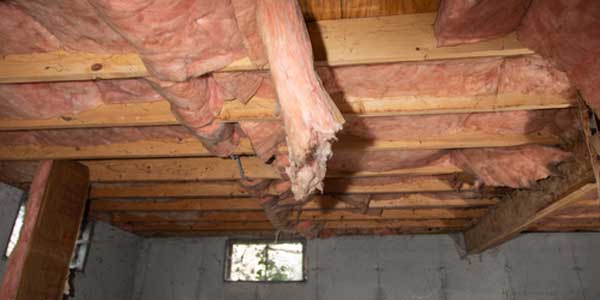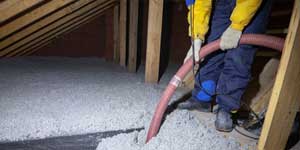St Louis - St Charles Insulation Company.


When You Need To Remove Old Insulation
If you’re planning to update the insulation in your home, you may be wondering what happens to the existing fiberglass insulation inside your walls and if you should even get rid of it before adding new insulation.
Your old insulation should not interfere with your new insulation installation, but that will depend on the type you’re removing as well as the type you’re putting in.
When You Should Remove Old Insulation
If you are replacing your current insulation with spray foam insulation, all pre-existing insulation should be removed before the new project. That’s because spray foam insulation results in a precise air seal. This tight barrier gives you lower energy bills, reduced noise and increased effectiveness of your HVAC units. In fact, this is likely why you’ve chosen this option in the first place.
However, spray foam can’t expand to create this air seal if the wall or attic is stuffed with old, dusty insulation. A reputable insulation contractor in St. Charles will use a powerful vacuum to suck up all that old fiberglass or cellulose insulation so the spray foam can better adhere to all the nooks and crannies. Your contractor will also haul carry away any old fiberglass batts for you.
If you have had rodents or other pests, you’ll want to remove the old insulation first. Rats and mice like to make their nests in loose-fill insulation and fiberglass batts, leaving behind urine and droppings. This saturates the insulation and causes a health hazard. You wouldn’t want to install new insulation over this tainted insulation, so it’s best to completely remove it first.
You will also want to remove the insulation if you have had water damage due to a roof leak, flood, or spilled condensation from your AC unit. That’s because insulation retains moisture for a long period of time, becoming a breeding ground for mold and mildew. It’s important to remove old waterlogged insulation before you add new insulation. Complete removal isn’t necessary, though – you can cut out the affected patches.
When You Don’t Have to Remove Old Insulation
There are some instances where you don’t necessarily have to get rid of the old to make way for the new. In some cases, it’s not only acceptable but preferable to keep old insulation where it is.
Leave it be if you are just adding more loose fill insulation, as it’s easy to squeeze some wherever you can, with no harmful chemical interactions between the two types.
Plus, adding new loose-fill insulation to the old can improve your home’s R-value, which saves you money on your energy bills while boosting the effectiveness of your home’s insulation. Just make sure the old insulation is in good shape. If you see evidence of water damage, pest infiltration or fire/smoke damage, throw it out and start anew.
Call Addict Insulation in St. Charles MO
Need more information on insulating old homes and have questions about needing to remve old insulation. Call our attic insulation contractors in St Charles & Lake of the Ozarks MO today at 636-233-7314. contact us for a free quote for insulation removal and replacement in the St Louis area
Energy Saving BlogPopular Articles
- FAQs About Insulation in Missouri
- What Areas Should You Insulate Before Winter?
- The Greatest Risks to Your Home Caused by Poor Insulation
- Why Your Utility Bills Are So High and What You Can Do About It
- Can You Put New Insulation Over Old?
- Here Are 3 Ways Your Attic Could be Contaminated
- How Home Insulation Works in the Summer
- Tips and Tricks For Summer Insulation
- How to Fix Indoor Condensation
- Choosing the Right Spray Foam Contractor
- Why You Need Power Washing This Spring
- Don't Let Air Escape Your Home
- Tips For Saving on Your Energy Bills This Summer
- Should I Install a Radiant Barrier in My Home?
- Are You Wondering if Your Attic Has Enough Insulation?
- Do I Have to Replace Wet Insulation?
- Insulating Your Sunroom
- Should You Insulate Your Outdoor Spaces?
- All About Removing Insulation
- What to Know About Insulating a Crawl Space
- How to Spot Mold in Your Wall Insulation
- How to Prevent Moisture in Your Warehouse With Spray Foam Insulation
- What Factors Cause Heat Gain?
- The Problems That Come With Improper Insulation
- Insulation FAQs
- Why Should You Check the Insulation When Buying a Home?
- Why Seal and Insulate Your Home?
- Home Insulation: Safety and Health
- Should You Remove Old Insulation During Replacement?
- Can I Stay Inside My Home During Spray Foam Insulation Installation?
- Pros and Cons of Converting an Attic
- Pros and Cons of Converting an Attic
- When’s the Best Time to Insulate Your House?
- The Difference Between Blown Insulation and Spray Foam Insulation
- Is Your Garage Loft Too Hot or Too Cold? Heed These Tips
- 6 Health Benefits of Having a Quiet Home
- Insulation Prep is Critical For Installation
- The Dangers of Removing Insulation on Your Own
- What’s the Most Eco-Friendly Insulation?
- 7 Benefits of Spray Foam Insulation
- What is the Proper Insulation For Vaulted Ceilings?
- Signs Your Crawlspace Insulation Should be Replaced
- Why You Should Insulate Your Basement Walls
- Most Effective Ways to Soundproof Your Home Office
- How to Insulate an Old House
- 4 Tips to Make Your Attic More Energy Efficient
- Attic Insulation Problems: 5 Things to Look Out For
- What Causes Condensation on Interior Walls?
- How Deep Should Your Insulation Be?
- What to Consider When Choosing an Insulation Company
- Can You Add New Insulation Layers Over Old Ones?
- When Should You Remove Insulation?
- 7 Tips For an Energy Efficient Summer
- Creating a Healthy, Comfortable and Productive Workspace When Working From Home
- Why is Roof Ventilation Just as Important as Insulation?
- Why Spring is a Good Time to Insulate Your Attic
- 5 Signs of Damaged or Insufficient Insulation
- Is the Insulation in Your Walls Making You Sick?
- Under-Insulated Areas You May Be Overlooking
- The History Of Insulation.
- Pros and Cons of Attic Insulation
- Do You Need Insulation When Finishing a Basement?
- What is Drill and Fill Insulation?
- Which Insulation is Best for Garage Walls?
- How Air is Escaping Your Home and How to Prevent It
- 10 Things You Must Absolutely Insulate Before Winter
- 5 Reasons To Not DIY Insulation
- 5 Signs of an Under-Insulated Home
- 5 Benefits of Blown Insulation
- Cellulose vs. Fiberglass Insulation
- When is Insulation Removal Necessary?
- Tips to Keep Your Home Cool This Summer
- What is the Best Insulation for a Flat Roof?
- 5 Benefits of Power Washing
- Q & A About Insulation
- Reviews
- Energy Saving Blog






